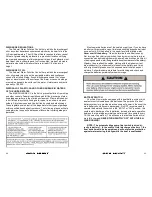
28
PERFORMANCE
PERFORMANCE FACTORS
Maximum performance is dependent on many factors and can-
not be guaranteed. These factors will vary with changing conditions.
Some of these factors are listed below.
ENGINE EFFICIENCY
Engines operate most efficiently at the RPM confirmed in the
engine operating manuals, assuming your boat is equipped with the
correct engines, the engines are properly tuned and the drive sys-
tems are in good condition. Efficiency will decrease if normal care
and maintenance is not performed. If engines are neglected power
will drop and speed will decrease. In addition, expensive repairs
may become necessary. Be sure to follow all instructions in the en-
gine operation manuals.
WEATHER CONDITIONS
Weather conditions affect engine performance. Barometric pres-
sure and humidity both influence horsepower. A change of weather
could cause a 10% loss in horsepower on some hot days.
LOAD DISTRIBUTION
A decrease in performance will be noticed when gear, equip-
ment, passengers and fuel are added. This type of extra load will
affect the performance of the boat according to the distribution of
the weight. Water accumulation in the bilge will also affect perform-
ance. Keep the bilge dry to eliminate this problem.
MARINE GROWTH
Maximum performance is obtained only when your hull bottom
is clean. Marine growth on the bottom of the boat will increase re-
sistance and decrease speed. These conditions will also increase
fuel consumption.
TRIM
Most outboard models are equipped with power tilt and trim
mechanisms. The purpose of power tilt function is to raise the en-
gine for launching, loading or trailering your boat. The power trim
function may be used to adjust the boats planing performance and
running attitude. Trim refers both to the weight distributions inside
the boat and to the angle of thrust of the drive unit. The angle of
thrust of the drive unit forces the bow up or down. The proper trim
angle will vary depending on the load and weight distribution in your
boat. If the drive is raised too far, you could cause the propeller to
"ventilate", resulting in a sudden increase in engine RPM and a loss
of speed. If this occurs, immediately reduce engine speed and
lower the drive until the condition is corrected.
37
MAINTENANCE & SERVICE
GENERAL
The amount of maintenance required to keep your boat operating
properly and to maintain the appearance is dependent on how the
boat is used, amount of usage, type of water, climate, etc.
Your hull and deck are constructed by the hand lay-up method
using the highest quality fiberglass mat and knitted non-woven fab-
rics. This method of construction ensures a proper fiberglass-to-resin
ratio and uniform thickness, which together result in boat of superior
strength, much stronger than boats constructed of “chopped glass”.
This process ensures that your Sea Hunt boat is the strongest, most
durable fiberglass boat possible.
The bilge areas should be kept clean and dry. Leaks found early
and corrected are less likely to cause damage. Do not allow grease
and dirt to build up.
Proper maintenance of your boat is not only a source of pride, it
is the key to maintaining your boat’s value. A few simple steps will
keep your fiberglass Sea Hunt looking showroom bright for years.
EXTERIOR FIBERGLASS FINISH
The exterior finish of your Sea Hunt is a thin layer of resin with a
finished color pigment called gelcoat. Its purpose is to protect the in-
ner laminate from moisture and chemicals and to give the parts the
glossy smooth colored finish that is the hallmark of fiberglass boats.
Although gelcoat has a hard smooth surface it does contain micro-
scopic pores that will allow surface discoloration if not kept clean.
MAINTENANCE
Normal exterior finish maintenance of your Sea Hunt boat is simi-
lar to the care you would give your automobile. Do not use caustic,
highly alkaline cleaners or those containing ammonia. These cleaning
agents may darken gelcoat. The resulting stain is a chemical reaction
and can be removed with a rubbing compound followed by waxing.
CLEANING
The best way to prevent discoloration and soil build-up is to hose the
boat with fresh water after each outing or on a regular basis. This
build-up is the result of use and environmental pollutants. Clean the
boat regularly with a mild household detergent and plenty of fresh
water. Use a sponge on smooth surfaces including the deck and a
brush on the nonskid. Rinse away all grime and residue.
WAXING
Gelcoat can lose its gloss due to constant exposure to the natural
environment and pollutants. It will require special attention to restore





































